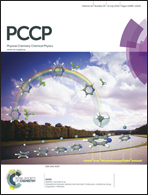Structural, electronic and energetic properties of giant icosahedral fullerenes up to C6000: insights from an ab initio hybrid DFT study†
Abstract
The properties of the (n,n) icosahedral family of carbon fullerenes up to n = 10 (6000 atoms) have been investigated through ab initio quantum-mechanical simulation by using a Gaussian type basis set of double zeta quality with polarization functions (84 000 atomic orbitals for the largest case), the hybrid B3LYP functional and the CRYSTAL14 code featuring generalization of symmetry treatment. The geometry of giant fullerenes shows hybrid features, between a polyhedron and a sphere; as n increases, it approaches the former. Hexagon rings at face centres take a planar, graphene-like configuration; the 12 pentagon rings at vertices impose, however, a severe structural constraint to which hexagon rings at the edges must adapt smoothly, adopting a bent (rather than sharp) transversal profile and an inward longitudinal curvature. The HOMO and LUMO electronic levels, as well as the band gap, are well described using power laws. The gap is predicted to become zero for n ≥ 34 (69 360 atoms). The atomic excess energy with respect to the ideal graphene sheet goes to zero following the log(Nat)/Nat law, which is well described through the continuum elastic theory applied to graphene; the limits for the adopted model are briefly outlined. Compared to larger fullerenes of the series, C60 shows unique features with respect to all the considered properties; C240 presents minor structural and energetic peculiarities, too.


 Please wait while we load your content...
Please wait while we load your content...